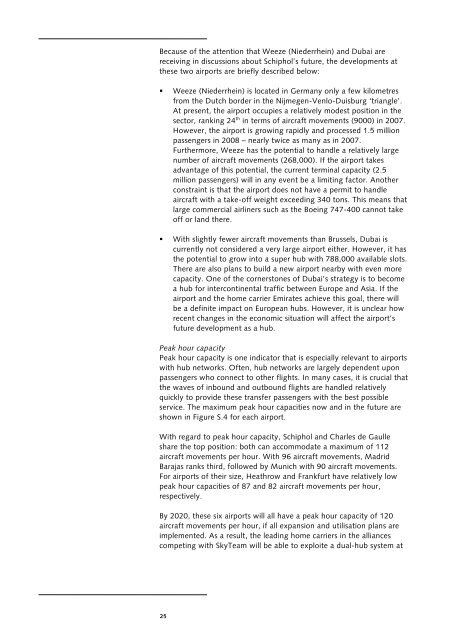Internationale benchmark capaciteit luchthavens - Kennisinstituut ...
Internationale benchmark capaciteit luchthavens - Kennisinstituut ...
Internationale benchmark capaciteit luchthavens - Kennisinstituut ...
You also want an ePaper? Increase the reach of your titles
YUMPU automatically turns print PDFs into web optimized ePapers that Google loves.
Because of the attention that Weeze (Niederrhein) and Dubai are<br />
receiving in discussions about Schiphol’s future, the developments at<br />
these two airports are briefly described below:<br />
Weeze (Niederrhein) is located in Germany only a few kilometres<br />
from the Dutch border in the Nijmegen-Venlo-Duisburg ‘triangle’.<br />
At present, the airport occupies a relatively modest position in the<br />
sector, ranking 24 th in terms of aircraft movements (9000) in 2007.<br />
However, the airport is growing rapidly and processed 1.5 million<br />
passengers in 2008 – nearly twice as many as in 2007.<br />
Furthermore, Weeze has the potential to handle a relatively large<br />
number of aircraft movements (268,000). If the airport takes<br />
advantage of this potential, the current terminal capacity (2.5<br />
million passengers) will in any event be a limiting factor. Another<br />
constraint is that the airport does not have a permit to handle<br />
aircraft with a take-off weight exceeding 340 tons. This means that<br />
large commercial airliners such as the Boeing 747-400 cannot take<br />
off or land there.<br />
With slightly fewer aircraft movements than Brussels, Dubai is<br />
currently not considered a very large airport either. However, it has<br />
the potential to grow into a super hub with 788,000 available slots.<br />
There are also plans to build a new airport nearby with even more<br />
capacity. One of the cornerstones of Dubai’s strategy is to become<br />
a hub for intercontinental traffic between Europe and Asia. If the<br />
airport and the home carrier Emirates achieve this goal, there will<br />
be a definite impact on European hubs. However, it is unclear how<br />
recent changes in the economic situation will affect the airport’s<br />
future development as a hub.<br />
Peak hour capacity<br />
Peak hour capacity is one indicator that is especially relevant to airports<br />
with hub networks. Often, hub networks are largely dependent upon<br />
passengers who connect to other flights. In many cases, it is crucial that<br />
the waves of inbound and outbound flights are handled relatively<br />
quickly to provide these transfer passengers with the best possible<br />
service. The maximum peak hour capacities now and in the future are<br />
shown in Figure S.4 for each airport.<br />
With regard to peak hour capacity, Schiphol and Charles de Gaulle<br />
share the top position: both can accommodate a maximum of 112<br />
aircraft movements per hour. With 96 aircraft movements, Madrid<br />
Barajas ranks third, followed by Munich with 90 aircraft movements.<br />
For airports of their size, Heathrow and Frankfurt have relatively low<br />
peak hour capacities of 87 and 82 aircraft movements per hour,<br />
respectively.<br />
By 2020, these six airports will all have a peak hour capacity of 120<br />
aircraft movements per hour, if all expansion and utilisation plans are<br />
implemented. As a result, the leading home carriers in the alliances<br />
competing with SkyTeam will be able to exploite a dual-hub system at<br />
25




